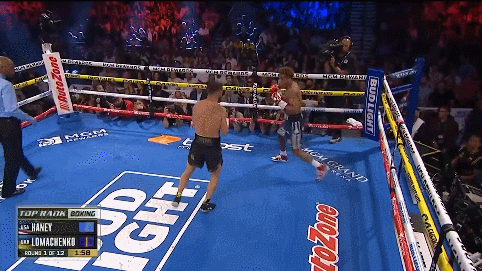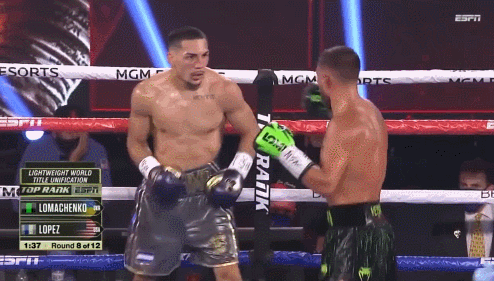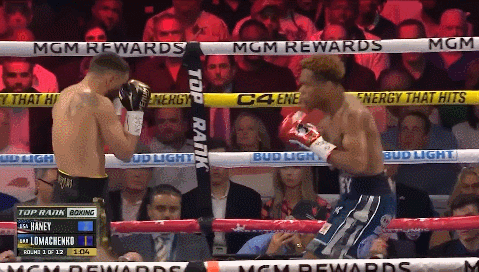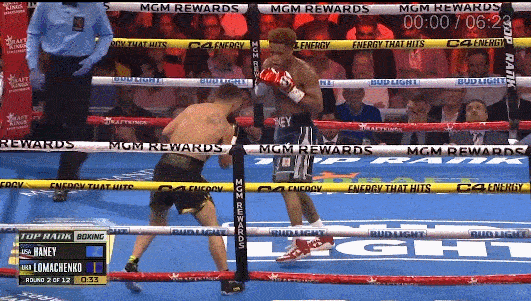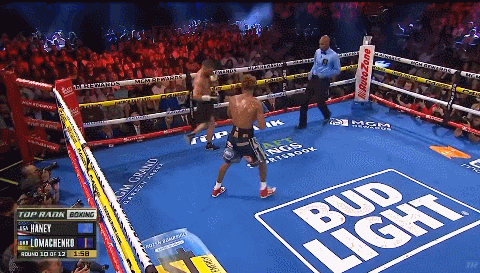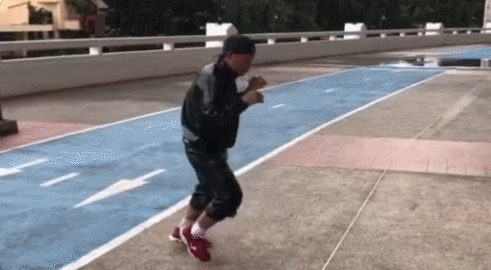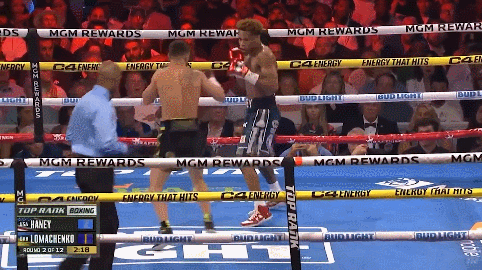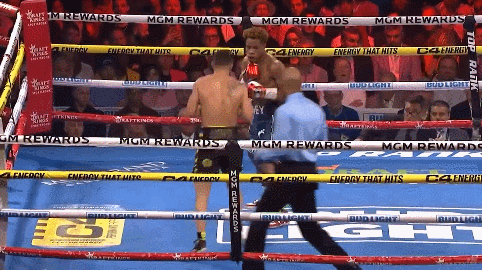It can be tempting to reduce an open stance match up to the idea of outside foot position. The southpaw shortens the line of his left straight by stepping outside the orthodox fighter’s lead foot, and the same is true for the orthodox fighter’s right straight if he achieves outside foot position. It is a simple factor to point out on a broadcast to give the casual viewer more insight when viewing the fight. But it is an idea that comes from the days where “The Southpaw” was seen as a fighter archetype in the same way “The Infighter”, “The Slugger” and “The Jabber” were. In reality no two southpaws are the same, not all of them are focused on shooting single left straights, and not all of them even seek outside foot position anymore.
Though the importance of the lead foot battle is often overstated, no southpaw in boxing does more with outside foot position than Vasyl Lomachenko. He does not take a small outside step to snipe a single left straight down the line of his shoulder, but instead gets around to the opponent’s flank and continues to hit and turn them with two-fisted combination punching.
In grappling, Gordon Ryan and John Danaher have spoken at length about the “jeopardy point”. That is, stepping around someone’s guard to the point that they must focus on getting you back in front of them. This puts the opponent in the position of frantically using energy to, at best, get back to a neutral position.
Lomachenko’s use of the outside angle resembles this. He circles past the opponent’s lead foot and shoulder to the point that their lead hand cannot hit him with pop and their lead shoulder shields him from their rear hand. They must get Lomachenko back in front of them if they hope to fight back. Most fighters pivot to face Lomachenko and he hits them on the pivot. Everyone trains for it, and everyone still ends up pivoting right into Lomachenko’s game at some point.
We discussed how Teofimo Lopez was able to mitigate the threat of Lomachenko getting the outside angle in Lopez vs Lomachenko: Stopping the Outside Angle. To quickly recap, Lopez’s methods were:
1) To try and time the left hook and pull into the clinch as Lomachenko stepped to the angle. This one was the least effective.
2) To unwind the angle, stepping back to the right as Lomachenko began his move to the outside position. This is a good option defensively, but required Lopez to read Lomachenko’s move to outside position, and failed to punish Lomachenko in order to deter future attempts.
3) To duck in and place a forearm across Lomachenko, physically pushing him back out of the angle as Lopez pivoted to face.
4) The most counter-intuitive of Lopez’s answers was to throw a right uppercut across himself. The outside angle puts a fighter past his opponent’s lead shoulder, meaning the left hook and jab are off the table and the right hand would have to travel all the way across the opponent’s body in a way that just isn’t natural. This weird uppercut never yielded a earth-shattering connection but it did seem to stifle Lomachenko and allowed Lopez to effectively scrape Lomachenko off his lead shoulder and back out to range.
Devin Haney’s answer to Lomachenko’s outside angle was first to fight for outside foot position at every opportunity. When Lomachenko did get to outside foot position, Haney ducked down into Lomachenko, and used the forearm across the body to shove Lomachenko out as he pivoted to face.
Richard Commey did this successfully for a couple of rounds against Lomachenko back in 2021. The technique was made better by Haney committing to over-pivot. The majority of Lomachenko’s opponents pivot to face him in the manner that they would in shadow boxing: a ninety degree turn and then it’s back to throwing punches. This is what Lomachenko expects and so he takes the angle, throws punches on the pivot, and moves just enough to take the angle again or escape out into space. Haney would step through almost a full one hundred and eighty degrees and end up facing Lomachenko with their ring positions almost completely reversed from the beginning of the exchange.
The other weapon Haney used was a terrific right uppercut to the body. I have to assume his coaches studied the Lopez – Lomachenko fight because while Lopez’s pivoting counter uppercut was a bit of a revelation the ones that really got in clean were the couple of occasions that he threw it to the body.
Haney’s best punch behind his marvellous jab has always been a wide right to the body. Against Lomachenko he brought his elbow in and started digging it into the floating rib as Lomachenko tried to take his outside angle. In spite of the general consensus that Lomachenko deserved the nod, Haney’s right uppercut seemed to be the most telling blow of the fight, sometimes even stopping Lomachenko in his tracks.
On the surface of it, dropping the right hand against a southpaw looking to get on the outside angle is asking to be hit with a left straight or even a booming overhand. But the way that Lomachenko tends to take his angle is to square his body and lean out to his right, as if looking out the window of a train. When Lomachenko angled without a punch, the right uppercut hit him in the solar plexus or left side. When he poked his left straight out, the exchanges became more of a gunfight, but he opened himself up for a stiffer connection as he exposed himself in extending.
Out in the open, Haney would often acquire outside foot position for himself and this allowed him to whip the right in with a bit more loop, as opposed to keeping the elbow tight.
Having such difficulty in acquiring his favourite angle, Lomachenko continued exploring with his other weapons. As we have mentioned, the outside foot position might be Lomachenko’s go-to but it is not the only aspect of an open stance match up. As Haney sought to keep his lead foot on the outside at all costs, Lomachenko was free to begin using Manny Pacquiao’s signature step (Fig. 1)
Fig. 1
The southpaw fighter steps his lead foot in (b) and either chooses inside foot position or his opponent insists on taking outside foot position for himself. As the southpaw fighter throws a left straight, his left foot comes up to square (c).
When compared to stepping to outside angle, this is a far more confrontational tactic. The attacking fighter presents more of a target because he squares himself up, but he also steps around to find the opponent’s centreline behind the blading of their stance and places both his hands about equidistant from the target. This enables him to continue with rapid, two-fisted hitting. This was Manny Pacquiao’s bread and butter and how he was able to rattle off combinations of four punches, alternating hands. Lomachenko’s flurries in the Haney fight were largely off this step, swinging his back foot around like a closing gate as his left hand shot in.
This fight also gives us an opportunity to touch on the idea of “rhythm steps” which have been demonized in some corners. The rhythm step is bouncing the lead foot back underneath you, or to look at it another way, abandoning stance. Here is a clip of Muay Thai great, Saenchai shadowboxing, wherein he commits the sin of the rhythm step after most combinations.
Quite rightly some coaches point out that this can be a bad or exploitable habit. If you do this after every combination you throw and the opponent follows you back, you can get caught in a fire fight without a stance let you duck, roll with punches, and most importantly hit back with power.
However, if you read Advanced Striking 2.0 - Jose ‘Mantequilla’ Napoles, you know that I think non-standard footwork is great. Mantequilla could box perfectly well without bringing his feet together, but when he did it was in aid of something unusual that the opponent wasn’t prepared for. Vasyl Lomachenko has completed 400 amateur fights, won numerous world titles, and hasn’t been knocked out off a rhythm step yet. Probably because he isn’t just using it to kill time or look cool, he is using it to show false entries and set up counters on galloping retreats.
Take this example: Lomachenko bounces his lead foot back underneath him, and even retreats into a full stance, before coming forward again. His bouncing numbs Haney to his intentions and he scores a stiff left straight out of the next bounce forwards.
Because that’s what the “rhythm” in “rhythm step” means: an established pattern. Good boxers notice patterns so if you are reliably doing a step that serves no purpose, of course that is exploitable. But Lomachenko shows patterns to build expectations and then breaks the rhythm to exploit his opponent’s anticipation. Shortening his stance when he is at extreme long range allows Lomachenko to then stab his lead foot in as a fake or what we call a “false entry”.
Here a false entry towards the outside angle gets Haney to duck down and get ready to pivot, then he hesitates when Lomachenko enters for real a second later.
You can see more of those stabs of the lead foot drawing big reactions from Haney here.
And just when the pattern seemed to be becoming more false entries than real ones, Lomachenko would stab in his lead foot, pause a beat, and throw the left straight from there.
Like most big boxing fights of the modern era, Devin Haney vs Vasyl Lomachenko is being remembered more for the controversy of the decision than the quality of the action in the ring. Perhaps keeping a sustained state of outrage at the incompetence / open corruption of officials in boxing will one day yield a significant change, but it is such a shame that now these two terrific fighters giving each other more than a handful in a great little bout will be lost in the shuffle.


